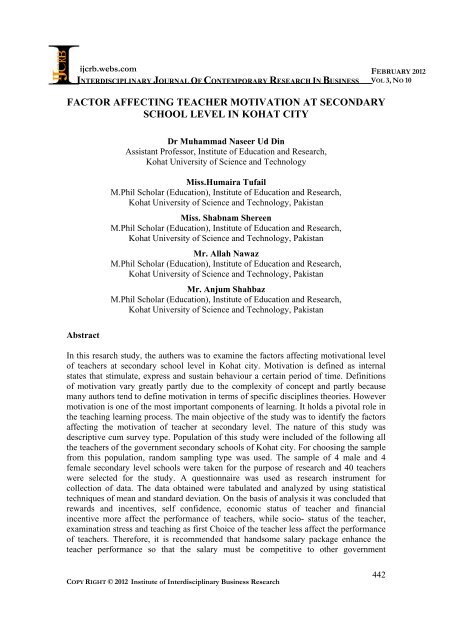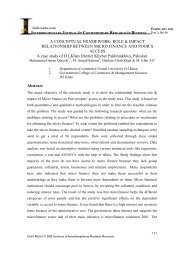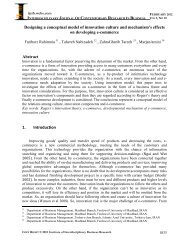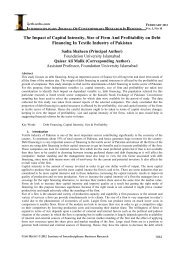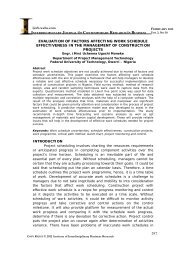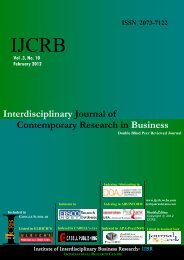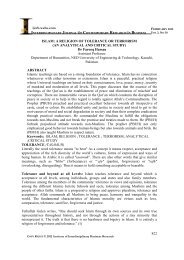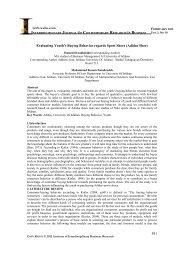factor affecting teacher motivation at secondary school level - journal ...
factor affecting teacher motivation at secondary school level - journal ...
factor affecting teacher motivation at secondary school level - journal ...
You also want an ePaper? Increase the reach of your titles
YUMPU automatically turns print PDFs into web optimized ePapers that Google loves.
ijcrb.webs.com<br />
INTERDISCIPLINARY JOURNAL OF CONTEMPORARY RESEARCH IN BUSINESS<br />
FEBRUARY 2012<br />
VOL 3, NO 10<br />
FACTOR AFFECTING TEACHER MOTIVATION AT SECONDARY<br />
SCHOOL LEVEL IN KOHAT CITY<br />
Dr Muhammad Naseer Ud Din<br />
Assistant Professor, Institute of Educ<strong>at</strong>ion and Research,<br />
Koh<strong>at</strong> University of Science and Technology<br />
Miss.Humaira Tufail<br />
M.Phil Scholar (Educ<strong>at</strong>ion), Institute of Educ<strong>at</strong>ion and Research,<br />
Koh<strong>at</strong> University of Science and Technology, Pakistan<br />
Miss. Shabnam Shereen<br />
M.Phil Scholar (Educ<strong>at</strong>ion), Institute of Educ<strong>at</strong>ion and Research,<br />
Koh<strong>at</strong> University of Science and Technology, Pakistan<br />
Mr. Allah Nawaz<br />
M.Phil Scholar (Educ<strong>at</strong>ion), Institute of Educ<strong>at</strong>ion and Research,<br />
Koh<strong>at</strong> University of Science and Technology, Pakistan<br />
Mr. Anjum Shahbaz<br />
M.Phil Scholar (Educ<strong>at</strong>ion), Institute of Educ<strong>at</strong>ion and Research,<br />
Koh<strong>at</strong> University of Science and Technology, Pakistan<br />
Abstract<br />
In this resarch study, the authers was to examine the <strong>factor</strong>s <strong>affecting</strong> <strong>motiv<strong>at</strong>ion</strong>al <strong>level</strong><br />
of <strong>teacher</strong>s <strong>at</strong> <strong>secondary</strong> <strong>school</strong> <strong>level</strong> in Koh<strong>at</strong> city. Motiv<strong>at</strong>ion is defined as internal<br />
st<strong>at</strong>es th<strong>at</strong> stimul<strong>at</strong>e, express and sustain behaviour a certain period of time. Definitions<br />
of <strong>motiv<strong>at</strong>ion</strong> vary gre<strong>at</strong>ly partly due to the complexity of concept and partly because<br />
many authors tend to define <strong>motiv<strong>at</strong>ion</strong> in terms of specific disciplines theories. However<br />
<strong>motiv<strong>at</strong>ion</strong> is one of the most important components of learning. It holds a pivotal role in<br />
the teaching learning process. The main objective of the study was to identify the <strong>factor</strong>s<br />
<strong>affecting</strong> the <strong>motiv<strong>at</strong>ion</strong> of <strong>teacher</strong> <strong>at</strong> <strong>secondary</strong> <strong>level</strong>. The n<strong>at</strong>ure of this study was<br />
descriptive cum survey type. Popul<strong>at</strong>ion of this study were included of the following all<br />
the <strong>teacher</strong>s of the government <strong>secondary</strong> <strong>school</strong>s of Koh<strong>at</strong> city. For choosing the sample<br />
from this popul<strong>at</strong>ion, random sampling type was used. The sample of 4 male and 4<br />
female <strong>secondary</strong> <strong>level</strong> <strong>school</strong>s were taken for the purpose of research and 40 <strong>teacher</strong>s<br />
were selected for the study. A questionnaire was used as research instrument for<br />
collection of d<strong>at</strong>a. The d<strong>at</strong>a obtained were tabul<strong>at</strong>ed and analyzed by using st<strong>at</strong>istical<br />
techniques of mean and standard devi<strong>at</strong>ion. On the basis of analysis it was concluded th<strong>at</strong><br />
rewards and incentives, self confidence, economic st<strong>at</strong>us of <strong>teacher</strong> and financial<br />
incentive more affect the performance of <strong>teacher</strong>s, while socio- st<strong>at</strong>us of the <strong>teacher</strong>,<br />
examin<strong>at</strong>ion stress and teaching as first Choice of the <strong>teacher</strong> less affect the performance<br />
of <strong>teacher</strong>s. Therefore, it is recommended th<strong>at</strong> handsome salary package enhance the<br />
<strong>teacher</strong> performance so th<strong>at</strong> the salary must be competitive to other government<br />
COPY RIGHT © 2012 Institute of Interdisciplinary Business Research<br />
442
ijcrb.webs.com<br />
INTERDISCIPLINARY JOURNAL OF CONTEMPORARY RESEARCH IN BUSINESS<br />
FEBRUARY 2012<br />
VOL 3, NO 10<br />
department, provision of <strong>at</strong>tractive salary package for yearly based revised and first step<br />
should be taken by district educ<strong>at</strong>ion office to understand the <strong>teacher</strong> problem and<br />
s<strong>at</strong>isfaction <strong>level</strong>.<br />
Key words: Motiv<strong>at</strong>ion, Motiv<strong>at</strong>ion <strong>factor</strong>, Teacher, Secondary <strong>level</strong><br />
1. Introduction<br />
It is a general tendency to believe th<strong>at</strong> <strong>motiv<strong>at</strong>ion</strong> is a personal trait. Some people<br />
have it and the others don’t. In practice, some are labeled to be lazy because they do not<br />
display an outward sign of <strong>motiv<strong>at</strong>ion</strong>. However, individuals differ in their basic<br />
<strong>motiv<strong>at</strong>ion</strong>al drives. It also depends upon their areas of interest. The concept of<br />
<strong>motiv<strong>at</strong>ion</strong> is situ<strong>at</strong>ional and its <strong>level</strong> varies between different individuals and <strong>at</strong> different<br />
times. If the people understand wh<strong>at</strong> motiv<strong>at</strong>es people, the people have <strong>at</strong> your command<br />
the most powerful tool for dealing with them.<br />
Motiv<strong>at</strong>ion is the desire or drive within a person to achieve some goal. Within<br />
is the oper<strong>at</strong>ive word here, for <strong>motiv<strong>at</strong>ion</strong> is an internal condition based on a person’s<br />
perceptions and needs (Ricks et al; 1995). The term <strong>motiv<strong>at</strong>ion</strong> derives from the L<strong>at</strong>in<br />
word movers, “to move”. It is virtually impossible to determine a person’s <strong>motiv<strong>at</strong>ion</strong><br />
until th<strong>at</strong> person behaviour or action an individual performs <strong>at</strong> each moment in time,<br />
the initi<strong>at</strong>ion and persistence of an intentional, goal - directed activity (Mifflin, 1995).<br />
Motiv<strong>at</strong>ion is getting others to do something because they want to do it. To<br />
motiv<strong>at</strong>e others is one of the most important management tasks. It comprises the<br />
abilities to understand wh<strong>at</strong> drives people, to communic<strong>at</strong>e, to involve, challenging, to<br />
encourage, setting an example, to develop and coach, to obtain feedback and to provide<br />
a just reward. Motiv<strong>at</strong>ion is about cultiv<strong>at</strong>ing your human capital. The challenge lies<br />
not in the work itself, but in you, the person who cre<strong>at</strong>es and manages the work<br />
environment (Cook, 1991).<br />
There are many <strong>factor</strong>s th<strong>at</strong> determine people's behaviour to motiv<strong>at</strong>e them.<br />
These are psychological needs, physiological drives, survival, urges, emotions, hurts,<br />
impulses, fears, thre<strong>at</strong>s, rewards (money, friendship, st<strong>at</strong>us), possessions, wishes,<br />
intentions, values, mastery, freedom, intrinsic s<strong>at</strong>isfaction, self-s<strong>at</strong>isfaction, interests,<br />
pleasure, dislikes, established habits, goals, ambitions and so on.<br />
People who are motiv<strong>at</strong>ed exert a gre<strong>at</strong>er effort to perform than those who are<br />
not motiv<strong>at</strong>ed. We know th<strong>at</strong> fear and money are not the only ways to motiv<strong>at</strong>e people<br />
to work. Human beings have reasons for the things th<strong>at</strong> they do. Our behaviour is not<br />
always. Human <strong>motiv<strong>at</strong>ion</strong> then, is the process whereby the behavior of an individual is<br />
energized, sustained, and directed in order to meet individual needs and achieve<br />
organiz<strong>at</strong>ion objectives.<br />
1.1 St<strong>at</strong>ement of the Problem<br />
The main purpose of this study was to find out the <strong>factor</strong>s affect the <strong>motiv<strong>at</strong>ion</strong><br />
of <strong>teacher</strong> <strong>at</strong> <strong>secondary</strong> <strong>level</strong> <strong>school</strong> in Koh<strong>at</strong> city.<br />
COPY RIGHT © 2012 Institute of Interdisciplinary Business Research<br />
443
ijcrb.webs.com<br />
INTERDISCIPLINARY JOURNAL OF CONTEMPORARY RESEARCH IN BUSINESS<br />
FEBRUARY 2012<br />
VOL 3, NO 10<br />
1.2 Objectives of the Study<br />
The study was based on the following objectives:<br />
(i)<br />
(ii)<br />
To identify the <strong>factor</strong>s <strong>affecting</strong> <strong>teacher</strong> <strong>motiv<strong>at</strong>ion</strong> <strong>at</strong> <strong>secondary</strong> <strong>level</strong>.<br />
To find out mean score of <strong>factor</strong>s <strong>affecting</strong> <strong>teacher</strong> <strong>motiv<strong>at</strong>ion</strong> <strong>at</strong> <strong>secondary</strong><br />
<strong>level</strong>.<br />
1.3 Significance of the Study<br />
The study would be helpful to identify the Factor <strong>affecting</strong> <strong>teacher</strong> <strong>motiv<strong>at</strong>ion</strong><br />
<strong>at</strong> <strong>secondary</strong> <strong>school</strong> <strong>level</strong> in Koh<strong>at</strong> city. This study would focus on effectiveness of<br />
Secondary educ<strong>at</strong>ion. Moreover this research detailed on studying the <strong>motiv<strong>at</strong>ion</strong>al<br />
ability of <strong>teacher</strong>s. Teachers is one of the gre<strong>at</strong> assent in our educ<strong>at</strong>ional institutions<br />
specially <strong>at</strong> elementary and <strong>secondary</strong> <strong>level</strong><br />
1.4 Delimit<strong>at</strong>ion of the Study<br />
Due to limited time and resources, the study was delimited to Government<br />
<strong>secondary</strong> <strong>school</strong>s of District Koh<strong>at</strong>. The institutions in priv<strong>at</strong>e sector were not being<br />
included in the sample.<br />
2. Review of Liter<strong>at</strong>ure<br />
Motiv<strong>at</strong>ion is one of the constructs psychologists have propounded in their<br />
quest for understanding the individual. Motiv<strong>at</strong>ion is the willingness to exert high<br />
<strong>level</strong>s of efforts towards organiz<strong>at</strong>ional goals conditioned by the efforts and ability to<br />
s<strong>at</strong>isfy some individual needs. Motiv<strong>at</strong>ion is an elusive concept including both the<br />
directing and energizing of behaviour. While controlling people’s behaviour can<br />
produce quick and dram<strong>at</strong>ic results, the desired behaviour tends to vanish when<br />
external controls fade away. Motiv<strong>at</strong>ion is the process of arousing, directing and<br />
maintaining behavior towards a goal. The act of arousing is rel<strong>at</strong>ed to the desire and<br />
vigor to produce. Directing is the election of behavior and maintenance is the<br />
inclin<strong>at</strong>ion to behave in a certain manner until the desired outcome is met (Greenberg<br />
1999).<br />
Motiv<strong>at</strong>ion is the willingness to do something and is continued by this action's<br />
ability to s<strong>at</strong>isfy some needs for the individual. Well-motiv<strong>at</strong>ed people are those with<br />
clearly defined goals who take action which they expect will achieve those goals.<br />
Motiv<strong>at</strong>ion is concerned with the strength and direction of th<strong>at</strong> behaviour. They make<br />
effective contributions <strong>at</strong> work because of strongly developed feelings of behavioural<br />
commitment. They must acknowledge th<strong>at</strong> their efforts are required to further both the<br />
need of the organiz<strong>at</strong>ion and their own interests. In other words <strong>motiv<strong>at</strong>ion</strong> is a<br />
COPY RIGHT © 2012 Institute of Interdisciplinary Business Research<br />
444
ijcrb.webs.com<br />
INTERDISCIPLINARY JOURNAL OF CONTEMPORARY RESEARCH IN BUSINESS<br />
FEBRUARY 2012<br />
VOL 3, NO 10<br />
management function th<strong>at</strong> stimul<strong>at</strong>es individuals to accomplish laid down institutional<br />
goals. It is purposive, design<strong>at</strong>ed and goal-oriented behaviour th<strong>at</strong> involves certain<br />
forces acting on or within the individual in order to initi<strong>at</strong>e, sustain and direct<br />
behaviour (Tolman, 1958).<br />
According to Cole (2000) <strong>motiv<strong>at</strong>ion</strong> is a term used to describe those processes,<br />
both initi<strong>at</strong>ive and r<strong>at</strong>ional by which people seek to s<strong>at</strong>isfy the basic drives, perceived<br />
needs and personal goals, which trigger off human behaviour. Motiv<strong>at</strong>e is a transitive<br />
verb, which means to give somebody an incentive, to give somebody a reason or<br />
incentive to do something. The exceptional leader realizes it is his/her responsibility to<br />
provide a highly motiv<strong>at</strong>ing environment for employees.<br />
Motiv<strong>at</strong>ion is not completely a new term. Wh<strong>at</strong> is interesting about it is th<strong>at</strong> it is<br />
commonly assumed to be a good thing th<strong>at</strong> goes in influencing individual's behaviour<br />
and performance <strong>at</strong> work. Motiv<strong>at</strong>ion is a feeling of interest th<strong>at</strong> makes you want to do<br />
something, a reason for doing something or behaving in a certain way. Motiv<strong>at</strong>ion<br />
comes from within, so it is up to each individual to motiv<strong>at</strong>e him/herself (Korman,<br />
1974).<br />
Teacher <strong>motiv<strong>at</strong>ion</strong> n<strong>at</strong>urally has to do with <strong>teacher</strong>s' <strong>at</strong>titude to work. It has to<br />
do with <strong>teacher</strong>s desire to particip<strong>at</strong>e in the pedagogical processes within the college<br />
environment. It has to do with <strong>teacher</strong>s' interest in student discipline and control<br />
particularly in the classroom. Therefore, it could underlie their involvement or noninvolvement<br />
in academic and non-academic activities, which oper<strong>at</strong>e in college. The<br />
<strong>teacher</strong> is the one th<strong>at</strong> transl<strong>at</strong>es educ<strong>at</strong>ional philosophy and objective into knowledge<br />
and skill and transfers them to students in the classroom. Classroom clim<strong>at</strong>e is<br />
important in <strong>teacher</strong> <strong>motiv<strong>at</strong>ion</strong>. If a <strong>teacher</strong> experiences the classroom as a safe,<br />
healthy, happy place with supportive resources and facilities for teaching for optimal<br />
learning, he/she tends to particip<strong>at</strong>e more than expected in the process of management,<br />
administr<strong>at</strong>ion and the overall improvement of the college. The <strong>teacher</strong> commands and<br />
transmits the image of one who improves knowledge and the physical conditions of the<br />
classroom through orderliness, discipline and control. He makes diagnosis of student's<br />
feelings and <strong>at</strong>titudes inferred by their behaviour and response in the classroom<br />
environment.<br />
Teachers have both intrinsic and extrinsic needs. A <strong>teacher</strong> who is intrinsically<br />
motiv<strong>at</strong>ed may be observed to undertake a task for its own sake, for the s<strong>at</strong>isfaction it<br />
provides or for the feeling of accomplishment and self-actualiz<strong>at</strong>ion. On the other hand,<br />
an extrinsically motiv<strong>at</strong>ed <strong>teacher</strong> may perform the activity/duty in order to obtain<br />
some reward such as salary. Extrinsic <strong>motiv<strong>at</strong>ion</strong> plays an important part in people's<br />
life. It is very important too strong in influencing a person's behaviour. Therefore, the<br />
aim of the organiz<strong>at</strong>ion should be to build on and enhance the intrinsic <strong>motiv<strong>at</strong>ion</strong> for<br />
<strong>teacher</strong>s to teach effectively and <strong>at</strong> the same time, to supply some extrinsic <strong>motiv<strong>at</strong>ion</strong><br />
along the way for college improvement (Kerlinger, 1993).<br />
COPY RIGHT © 2012 Institute of Interdisciplinary Business Research<br />
445
ijcrb.webs.com<br />
INTERDISCIPLINARY JOURNAL OF CONTEMPORARY RESEARCH IN BUSINESS<br />
FEBRUARY 2012<br />
VOL 3, NO 10<br />
3. Methods and Procedure<br />
This is a survey type of research designed to obtain suitable and inform<strong>at</strong>ion<br />
concerning the current st<strong>at</strong>us of the problem. General conclusions are drawn about the<br />
actual facts.<br />
3.1 Popul<strong>at</strong>ion:<br />
The Study was descriptive cum survey in n<strong>at</strong>ure. All the government <strong>teacher</strong>s of<br />
<strong>secondary</strong> <strong>school</strong>s of boys and girls of the District Koh<strong>at</strong> constituted popul<strong>at</strong>ion of the<br />
study.<br />
3.2 Delimit<strong>at</strong>ion of the Study<br />
This study was delimited to the following:<br />
(a) Four male <strong>secondary</strong> <strong>school</strong>s of Koh<strong>at</strong> city.<br />
(b) Four female <strong>secondary</strong> <strong>school</strong>s of Koh<strong>at</strong> city.<br />
3.3 Sample:<br />
The sample of this study consisted of eight <strong>secondary</strong> <strong>school</strong>s of the District Koh<strong>at</strong>. It is<br />
further included 40 <strong>teacher</strong>s were selected randomly from 8 <strong>secondary</strong> <strong>school</strong>s 4 male<br />
and 4 female as a sample out of which 20 were male <strong>teacher</strong>s and 20 were female<br />
<strong>teacher</strong>s.<br />
3.4 Research Instruments:<br />
Questionnaires were used as a research instruments. One questionnaire<br />
was prepared for <strong>teacher</strong>s of <strong>secondary</strong> <strong>school</strong>s of the District Koh<strong>at</strong>. The<br />
questionnaires were developed on the form<strong>at</strong> of closed ended questions which<br />
covered all the aspects of <strong>teacher</strong> rel<strong>at</strong>ed <strong>factor</strong> such as reward and incentive <strong>at</strong><br />
<strong>secondary</strong> <strong>school</strong>s <strong>level</strong>.<br />
3.5 D<strong>at</strong>a Collection:<br />
D<strong>at</strong>a from the field was collected through questionnaires. The researcher<br />
administered the questionnaires personally. The researcher visited the <strong>school</strong>s<br />
mentioned in the sample for obtaining the opinions of the <strong>teacher</strong>s of the <strong>at</strong><br />
<strong>secondary</strong> <strong>school</strong>s <strong>level</strong> in the District Koh<strong>at</strong>.<br />
COPY RIGHT © 2012 Institute of Interdisciplinary Business Research<br />
446
ijcrb.webs.com<br />
INTERDISCIPLINARY JOURNAL OF CONTEMPORARY RESEARCH IN BUSINESS<br />
FEBRUARY 2012<br />
VOL 3, NO 10<br />
3.6 D<strong>at</strong>a Analysis:<br />
The d<strong>at</strong>a obtained were tabul<strong>at</strong>ed and analyzed by using st<strong>at</strong>istical techniques like<br />
mean and standard devi<strong>at</strong>ion. On the basis of analysis and interpret<strong>at</strong>ion of d<strong>at</strong>a,<br />
conclusions were drawn and recommend<strong>at</strong>ions were made.<br />
4. Results and Discussion<br />
Table 1 indic<strong>at</strong>es th<strong>at</strong> the overall mean scores of <strong>motiv<strong>at</strong>ion</strong>al <strong>factor</strong>s regarding<br />
<strong>teacher</strong> <strong>motiv<strong>at</strong>ion</strong> <strong>level</strong>, ability and their interest and sprit. The above table elabor<strong>at</strong>e<br />
their result through means score of each <strong>factor</strong>s among eight different <strong>motiv<strong>at</strong>ion</strong> <strong>factor</strong>s.<br />
However, the highest mean score was on the <strong>factor</strong> of reward and incentives (2.82); the<br />
second highest mean score was on the <strong>factor</strong> of self confidence (2.65), followed by<br />
apprehension and anxiety in classroom (2.57), Economic - st<strong>at</strong>us of the <strong>teacher</strong> (2.55),<br />
rel<strong>at</strong>ionship of <strong>teacher</strong> with their colleagues (2.45), socio- st<strong>at</strong>us of the <strong>teacher</strong> and<br />
examin<strong>at</strong>ion stress both (2.38); and the low mean score was on the <strong>factor</strong> of teaching as<br />
first choice (2.15)<br />
Table 1: Mean and Standard Devi<strong>at</strong>ion of Principal’s Perception<br />
Scores about Factors regarding Motiv<strong>at</strong>ion N Mean S. D.<br />
Teaching as First Choice 40 2.15 .580<br />
Socio- St<strong>at</strong>us of the Teacher 40 2.38 .705<br />
Economic - St<strong>at</strong>us of the Teacher 40 2.55 .714<br />
Self Confidence 40 2.65 .622<br />
Apprehension and Anxiety in Classroom 40 2.57 .594<br />
Rel<strong>at</strong>ionship of Teacher with their Colleagues 40 2.45 .597<br />
Examin<strong>at</strong>ion Stress 40 2.38 .628<br />
Rewards and Incentives 40 2.82 .385<br />
From the results in Table 1, it was concluded th<strong>at</strong> <strong>teacher</strong>s perceived th<strong>at</strong> their<br />
<strong>motiv<strong>at</strong>ion</strong>al <strong>level</strong> <strong>teacher</strong>s were more affect the performance of <strong>teacher</strong>s on the aspect of<br />
rewards and incentives, self confidence and economic st<strong>at</strong>us of <strong>teacher</strong> while less affect<br />
the performance of <strong>teacher</strong>s on the <strong>factor</strong>s of socio- st<strong>at</strong>us of the <strong>teacher</strong>, examin<strong>at</strong>ion<br />
stress and teaching as first Choice<br />
COPY RIGHT © 2012 Institute of Interdisciplinary Business Research<br />
447
ijcrb.webs.com<br />
INTERDISCIPLINARY JOURNAL OF CONTEMPORARY RESEARCH IN BUSINESS<br />
FEBRUARY 2012<br />
VOL 3, NO 10<br />
5. Conclusion<br />
The study found th<strong>at</strong> <strong>motiv<strong>at</strong>ion</strong>al <strong>factor</strong> could clearly identify the performance<br />
<strong>level</strong> of the person. Performance can be very good when a person performed their<br />
responsibilities. In fact motiv<strong>at</strong>ed <strong>teacher</strong>s show their performance very high and fulfill<br />
their responsibilities adequ<strong>at</strong>ely. In this way educ<strong>at</strong>ional institutions achieve good<br />
standards. It means th<strong>at</strong> responsibilities of the <strong>teacher</strong>s are essential <strong>factor</strong>s in the<br />
instructional programme for the <strong>teacher</strong>’s performance.<br />
The majority of the <strong>teacher</strong>s view th<strong>at</strong> the <strong>motiv<strong>at</strong>ion</strong>al <strong>factor</strong>s like rewards and<br />
incentives, self confidence and economic st<strong>at</strong>us of <strong>teacher</strong> more affect the performance of<br />
<strong>teacher</strong>s. The study results show th<strong>at</strong> the majority of the <strong>teacher</strong>s view th<strong>at</strong> <strong>motiv<strong>at</strong>ion</strong>al<br />
<strong>factor</strong>s like good rel<strong>at</strong>ionships with their colleague, feedback on academic performance,<br />
and financial incentive also affect the <strong>motiv<strong>at</strong>ion</strong>al <strong>level</strong> of <strong>teacher</strong>s.<br />
The study results express th<strong>at</strong> the majority of the <strong>teacher</strong>s view th<strong>at</strong> <strong>motiv<strong>at</strong>ion</strong>al<br />
<strong>factor</strong>s like socio- st<strong>at</strong>us of the <strong>teacher</strong>, examin<strong>at</strong>ion stress and teaching as first Choice<br />
less affect the performance of <strong>teacher</strong>s<br />
6. Recommend<strong>at</strong>ions<br />
It was found th<strong>at</strong> motiv<strong>at</strong>ed <strong>teacher</strong>s perceive th<strong>at</strong> they will fulfill their<br />
responsibilities by exerting maximally. Therefore, it is recommended th<strong>at</strong> <strong>motiv<strong>at</strong>ion</strong><br />
techniques may be included in detail in training courses of <strong>teacher</strong>s and a special training<br />
course may be arranged for educ<strong>at</strong>ional managers, administr<strong>at</strong>ors and supervisors to use<br />
<strong>motiv<strong>at</strong>ion</strong> techniques appropri<strong>at</strong>ely to achieve competency<br />
It was found th<strong>at</strong> economic st<strong>at</strong>us and financial incentive of <strong>teacher</strong> more affect<br />
the performance of <strong>teacher</strong>s. Therefore, it is recommended th<strong>at</strong> to enhance the <strong>teacher</strong><br />
performance it is vital th<strong>at</strong> the salary must be competitive to other government<br />
department, for this a yearly based survey should be taken by district educ<strong>at</strong>ion office to<br />
understand the <strong>teacher</strong> problem and s<strong>at</strong>isfaction <strong>level</strong>.<br />
COPY RIGHT © 2012 Institute of Interdisciplinary Business Research<br />
448
ijcrb.webs.com<br />
INTERDISCIPLINARY JOURNAL OF CONTEMPORARY RESEARCH IN BUSINESS<br />
FEBRUARY 2012<br />
VOL 3, NO 10<br />
References<br />
Cook, M. 1991. 10-Minute Guide to Motiv<strong>at</strong>ing People. Alpha Book Publishers, New<br />
York, USA. P.122.<br />
Cole, G.A.2000. Management Theory and Practice, Lens Educ<strong>at</strong>ional Aldine Place:<br />
London. P. 28.<br />
Greenberg, J. 1999. Managing Behavior in Organiz<strong>at</strong>ional. 2nd ed. Prentice Hall, New<br />
Jersey, USA. P.74, 136.<br />
Korman, A. R, 1974. The Psychology of Motiv<strong>at</strong>ion. Englewood Cliffs, N. J. Prentice<br />
Hall, New Jersey, UK. P.191.<br />
Kleinginna, P. Jr. and A. Kleinginna. 1981. Motiv<strong>at</strong>ion and Emotion. Prentice Hall,<br />
New Jersey, USA. P. 263.<br />
pp. 141-165.<br />
Mifflin, 1995. Management and Organiz<strong>at</strong>ion. South-Western Publishing Co, New<br />
York, USA. P.122, 167.<br />
Ricks, B.R., M.L.Glinn and A.S.Daughtrey. 1995. Contemporary supervision,<br />
Managing People and technology, McGraw- Hill, Inc. New York, USA.<br />
P.169,182,<br />
Tolman, E. 1958. Behaviour and Physiological Man.Barkelely, University of California<br />
Press, California, USA.P.132.<br />
COPY RIGHT © 2012 Institute of Interdisciplinary Business Research<br />
449


